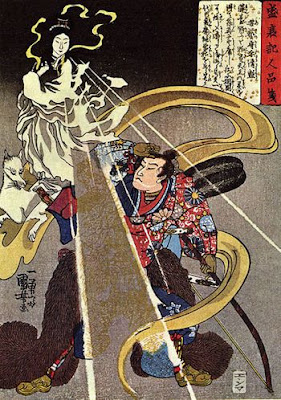Research: Kami
I have already researched about Shinto, which is the largest religion of Japan, and now I will research about Kami in general and what are their rolles in society. I believe this will inform my work because there mught be some feature that I can use connected to their origin or at least avoid incorporating elements that are not connected with them.
Kami
"I do not yet understand the meaning of the word 'kami'. In the most general sense, it refers to all divine beings of heaven and earth that appear in the classics. More particularly, the kami are the spirits that abide in and are worshipped at the shrines." (Norinaga M., n.d.)
The word "God" when translated into Japanese is commonly represented by the kanji 神 and it is pronounced kami. However, it is important to understand that these are three different concepts that should not be compared. Kami, is a term that embraces not only gods and goddesses but also animal spirits, deities from other religions (as Budhism), ancestors, natural phenomenas and landscape elements (as mountains for example). Because they influence people's everyday lives, they are given offerings and often asked for help in exchange.
"All of the Kami occasionally, in times of great crisis, assemble for conference on the dry riverbed of the Heavenly River" (Catwright M., 2017)
Kami live in the same world as us and they are not from a different kind, they're just a greatest version of the life energy. There are many different ways to categorise the Kami - it can be for their function, their nature but M. Ashkenazi's distinguishes them by two different types: the firsts, who remain in the heavens (amatsukami - heavenly kami); and those who are part of te next generation of kami's that first ruled on Earth (Kunitsukami - eathly kami). As the citation said, these two reunite in times of crisis near the Heavenly River.
It is also important to understand that there good and bad kami's. Contrary to western gods, they are not perfect and can behave badly. Furtermore, they are not alo omnipotent. However, they can answer to human prays and interfere in the course if human events or even natural forces.
Moreover, the Kami are not represented by an image and some of them don't even have a name or story. This might be beneficial or not for my project. On one hand because there is no image associated to it I will have more space to be creative. On the other hand, I don't have many references to use which might complicate my work.
There was not much information about the kami's in general as I expected, or at least it was not contextual to my work. However, I found an anime very interesting entiled Noragami (2010) illustrated and written by Adachitoka, which helped me to understand these as well as how Japanese people see kami. If you're instered or you like anime here is the link for the trailer: https://www.youtube.com/watch?v=8JGfx2_kL-I. I highly recommend it and it definetely informed my work especially regarding some individual kami.
References:
Cartwright K. (2017) Kami [online] World History, Available from: https://www.worldhistory.org/Kami/ [Accessed 24.04.2021]
Daisaburo H. (2014) Kami: The Evolution of Japan’s Native Gods [online] nippon.com, Available from: https://www.nippon.com/en/in-depth/a02902/ [Accessed 24.04.2021]
BBC (2009) Kami [online] Available from: https://www.bbc.co.uk/religion/religions/shinto/beliefs/kami_1.shtml [Accessed 24.04.2021]
Spacey J. (2015) Meet the Gods: 13 Japanese Kami [online] Japanese Talk, Available from: https://www.japan-talk.com/jt/new/kami[Accessed 24.04.2021]


Comments
Post a Comment